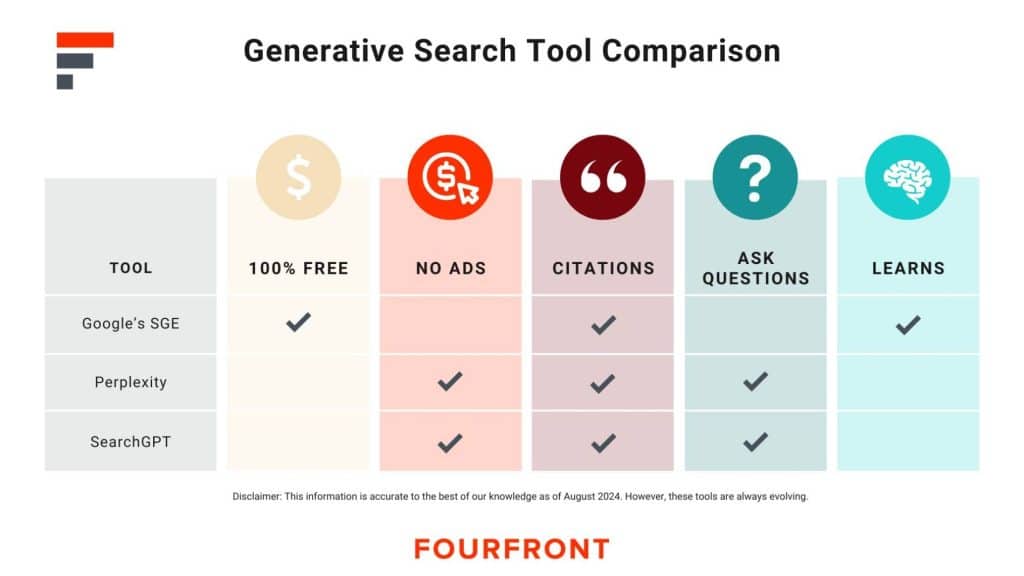This content is up-to-date and accurate as of August 2024. However, the generative search landscape is evolving quickly. If you notice any outdated information, please feel free to contact us and let us know!
Let’s face it, friends, generative search is transforming how we interact with search engines.
This new (and super cool) development is all about delivering results that are personalized and contextually relevant, thanks to AI technologies like machine learning and natural language processing.
There are a lot of players in the generative search game. Platforms like SearchGPT and Perplexity are leading the charge, offering conversational and detailed search experiences. Meanwhile, Google’s Search Generative Experience (SGE) is shaking things up by integrating AI-generated summaries into search results.
What does this mean for businesses? It’s time to take a fresh look at your digital marketing strategy.
Generative search is not just enhancing engagement—it’s changing how content is perceived and consumed. Adapting to these changes isn’t just a good idea; it’s essential for staying competitive in this rapidly evolving landscape.
Why Is Google’s Search Generative Experience Important?
It’s no exaggeration to say that Google’s Search Generative Experience (SGE) is reshaping digital marketing.
Unlike traditional search engine results, SGE provides immediate answers directly in the search results, reducing the need for users to navigate through multiple links. And the fact that SGE is present right on the Google search engine results page (SERP), means this technology is being put in front of an incredibly vast audience of users. Other generative search tools, on the other hand, require users to change their search behavior – and even use a separate site or app entirely.
How Does SGE Work?
Search Generative Experience leverages advanced AI algorithms to revolutionize how search engines interpret and respond to user queries.
By utilizing machine learning and natural language processing, SGE moves beyond simple keyword matching to truly understand the intent behind each search. This allows it to deliver results that are not only more personalized but also contextually relevant.
Google’s Search Generative Experience excels at breaking down complex queries. It considers various factors such as user history and search patterns to tailor its responses. This continuous learning process enables SGE to refine its predictions over time, ensuring that users receive the most accurate and relevant information possible.
For businesses and content creators, this means that crafting content needs to be more than just about keywords. It should be contextually rich and user-centric, aligning with SGE’s focus on delivering results that closely match user needs. By understanding and adapting to these nuances, businesses can better position their content to meet the demands of this sophisticated search environment.
Alternatives to Google’s SGE
SearchGPT
SearchGPT is an AI-powered search engine developed by OpenAI that offers a unique, conversational search experience. Here’s what sets it apart:
Conversational Format:
- Provides direct answers in a chat-like interface.
- Allows users to ask follow-up questions, maintaining the context of the conversation for more precise information.
User-Friendly Features:
- Offers an ad-free search environment, ensuring a cleaner and more focused user experience.
- Provides clear attributions and source links for information, enabling users to verify content and explore further.
Distinct from SGE:
- Unlike Google’s Search Generative Experience (SGE), which integrates AI-generated summaries into traditional search results, SearchGPT focuses on interactive, real-time dialogue.
SearchGPT represents a significant advancement in generative search, combining the immediacy of direct answers with the depth of conversational AI.
Perplexity
Perplexity is an AI-powered search engine designed to help users find detailed answers and understand complex topics. Plus, it’s my current personal favorite AI tool. Here’s what makes it unique:
Comprehensive Answers:
- Provides detailed responses by gathering information from various sources.
- Focuses on delivering clear answers with citations, allowing users to verify the information.
User Experience:
- Offers an ad-free environment, ensuring a smooth and uninterrupted search experience.
- Prioritizes clarity and depth in its search results, making it easier for users to navigate complex topics.
Distinct from SGE:
- Unlike Google’s Search Generative Experience (SGE), which integrates AI-generated summaries into traditional search results and includes ads, Perplexity focuses on comprehensive, citation-backed answers without advertisements.
Perplexity aims to provide users with a reliable and seamless search experience, emphasizing transparency and depth in information retrieval.

How Is Optimizing for Generative Search Different from Traditional SEO?
SEO has long been about keywords, backlinks, and technical tweaks. Generative search, however, demands a deeper dive into understanding user intent and context. It’s about crafting content that answers complex, conversational questions with precision and relevance.
Generative search emphasizes quality and engagement over mere keyword density. It requires content that is structured, informative, and tailored to meet the nuanced needs of users. This shift means moving away from keyword stuffing and focusing on creating meaningful, user-centric content that resonates with the audience.
In this new landscape, staying updated with evolving algorithms and continuously refining content is key to maintaining visibility and relevance.
Generative Search Optimization Strategies
1. Craft Content for Conversational Queries
Create content that addresses conversational queries. Use natural language and long-tail keywords. Make sure your content resonates with your audience.
2. Enhance Content Structure for User Engagement
Structure your content clearly. Use headings, bullet points, and concise paragraphs. Generative search favors content that’s easy to read and navigate.
3. Update Content for Relevance
Keep your content fresh. Regular updates ensure it remains relevant and competitive. Generative search trends evolve quickly; stay ahead of the curve.
4. Creating Topic Clusters for Enhanced Content Visibility
Develop topic clusters that cover related subjects. Generative search favors well-organized content, boosting visibility and authority.

A quick side note from the author:
None of these tips are anything new or earth-shattering. It has long been best practice in the world of SEO to create valuable, informative, well-structured content that is attentive to your audience and what they’re really looking for.
Keyword stuffing and writing with the intent to “dupe” the search engine has been a bad move for several years now.
If you’ve been paying attention (and the fact that you’re reading this blog suggests that maybe you have), chances are you’re already doing a lot of these things right. Generative search and SGE are just the next evolution of search that prioritizes user experience and high-quality content.
All that to say, there isn’t a magical new strategy to employ or technical hack to roll out that will make your content suddenly perform well in generative search. The answer is still, “just make valuable, quality content.”
Adapting to Generative Search
In the ever-evolving digital world, adapting to generative search is essential for maintaining a strong online presence.
Understanding how tools like Search Generative Experience (SGE) function is key to staying competitive. It’s all about diving into user intent and context to create content that’s not just informative, but truly engaging.
To succeed, focus on crafting content that aligns with these advanced algorithms. This approach will boost your visibility and keep your audience engaged. Remember, the digital landscape is always changing, so commit to continuous learning, regularly update your content, and ensure it remains authoritative.
By adopting these strategies, you’ll be well-prepared to navigate the dynamic search environment and achieve success in a competitive digital market.












